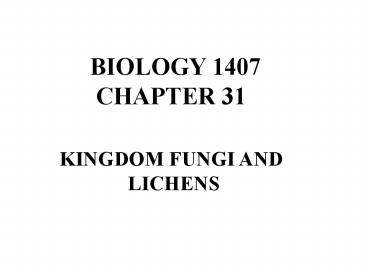BIOLOGY 1407 - PowerPoint PPT Presentation
1 / 39
Title:
BIOLOGY 1407
Description:
BIOLOGY 1407 CHAPTER 31 KINGDOM FUNGI AND LICHENS Fungi as Decomposers Fungal Mycelium Hyphae Predatory Fungi Hyphae Fungal Life Cycle Fungal Diversity Fungal ... – PowerPoint PPT presentation
Number of Views:193
Avg rating:3.0/5.0
Title: BIOLOGY 1407
1
BIOLOGY 1407 CHAPTER 31
KINGDOM FUNGI AND LICHENS
2
KINGDOM FUNGI
- Multicellular
- Mostly terrestrial
- Absorptive heterotrophic nutrition.
- Parasitic, saprophytic or mutualistic.
- Chitin cell walls.
- Do not produce flagellated cells.
- Septate (divided by cross walls)and
- non septate (no cross walls) hyphae.
- Vegetative thallus haploid, mycelium
3
Fungi as Decomposers
4
Fungal Mycelium
5
Hyphae
6
Predatory Fungi
7
Hyphae
Non-Septate
Septate
8
Fungal Life Cycle
9
Fungal Diversity
10
Fungal Diversity
11
Phylum Chytridiomycota
- Flagellated Zoospores and Gametes
- Absorptive Nutrition
- Chitin Cell Walls
- Most Produce Hyphae
- Metabolism Similar to True Fungi
- Primitive Fungi
- Retain Flagella
12
Phylum Chytridiomycota
13
PHYLUM ZYGOMYCOTA
- Coenocytic thallus with nonseptate hyphae.
- Form endomycorrhizal associations
- with thousands of vascular plants.
- Asexual reproduction - upright
- sporangiophore with a sac-like
- sporangium at the tip.
- Sexual reproduction by conjugation
- and zygospore formation, no fleshy
- fruiting bodies.
- Black bread mold - Rhizopus stolonifera
14
Rhizopus stolonifera Life Cycle
15
Rhizopus
16
Rhizopus Sexual reproduction
17
Microsporidia
- Unicellular
- Parasites of Animals and Protists
- Very Unusual Mitochondria
- Molecular Evidence Suggest that they are
Zygomycota - Parasitic Lifestyle
18
PHYLUM GLOMEROMYCOTA
- Previously With Zygomycota
- Small Monophyletic Clade
- Endomycorrhizae Arbuscular Mycorrhizae
- Produce branching Arbuscules
19
PHYLUM ASCOMYCOTA
- 30,000 species.
- Sac or cup fungi.
- Perforated cross walls or septa.
- Produce dikaryotic hyphae during
- the life cycle.
- Sexual reproduction involves
- the formation of an ascocarp with
- elongate cells (asci, ascus singular)
- that produce ascospores.
20
PHYLUM ASCOMYCOTA
- Three types of ascocarps are produced.
- Apothecium - Cup like shape.
- Perithecium - Flask like shape.
- Cleistothecium - Globose, no opening.
- Asci make up the inner lining of the
- ascocarps.
- Asexual reproduction by the production
- of conidiospores (spores that bud
- from the tip of the hypha).
- Conidiophore
- Many parasitic ie. Chestnut blight, Truffles,
yeast
21
PHYLUM ASCOMYCOTA
22
PHYLUM ASCOMYCOTA
Ascocarps
23
Ascomycota Types
24
Aspergillua
25
Ascomycota - Structure
26
Ascospores
27
PHYLUM BASIDIOMYCOTA
- 25,000 species.
- Some have very complex life cycles.
- Basidium - Club shaped terminal cell
- that produces sexual spores.
- Basidiospores - Sexual spores.
- Asexual spores are not conidia.
- Many have dolipore septa.
- Produce dikaryotic cells.
- Mushrooms, bracket and shelf fungi,
- smuts and rust, polyporous fungi.
28
Basidiomycota Types
29
PHYLUM BASIDIOMYCOTA
30
PHYLUM BASIDIOMYCOTA
Basidiospores
Basidium
31
Mushrooms
32
Basidiospores
33
PHYLUM DEUTEROMYCOTA No Longer Exist
- 22,000 species.
- Saprophytic, parasitic and
- predatory.
- Many produce conidia and appear
- to be ascomycetes, but have no
- sexual phase.
- Fusarium wilt of tomato, potato
- and cotton.
- Athletes foot, ring worm
34
FUNGI IN THE ENVIRONMENT
- Decomposers
- Plant Diseases
- Lichens
- Crustose
- Foliose
- Fruticose
- Mycorrhizae
- Endo and Ecto
35
Lichen Anatomy
36
LICHENS
Crusrose
Fruticose
Foliose
37
Mycorrhizae
38
(No Transcript)
39
FUNGI HUMAN IMPACT
Fermentation Antibiotics Food Processing Food Plan
t Disease Animal Disease Agricultural Diseases































